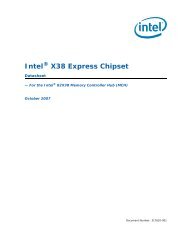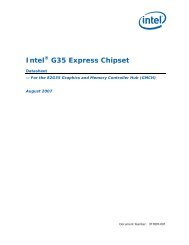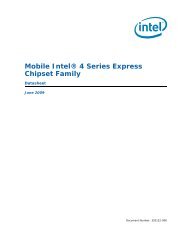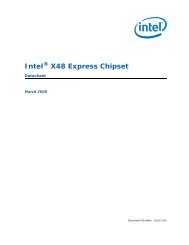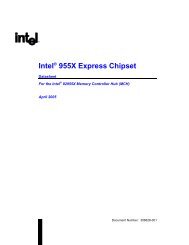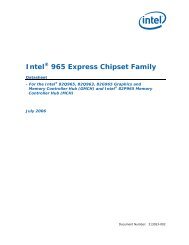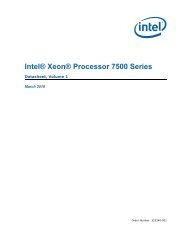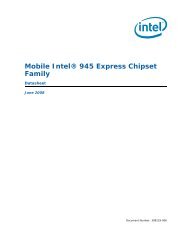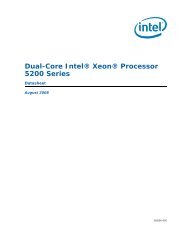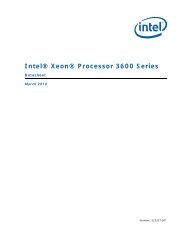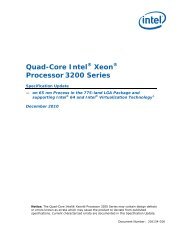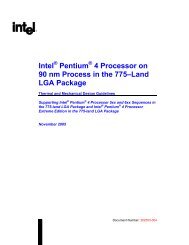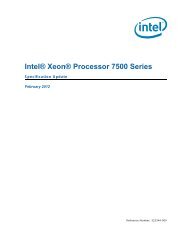Intel® 945G/945GZ/945GC/ 945P/945PL Express Chipset Family ...
Intel® 945G/945GZ/945GC/ 945P/945PL Express Chipset Family ...
Intel® 945G/945GZ/945GC/ 945P/945PL Express Chipset Family ...
Create successful ePaper yourself
Turn your PDF publications into a flip-book with our unique Google optimized e-Paper software.
3 Register Description<br />
Register Description<br />
The (G)MCH contains two sets of software accessible registers, accessed via the Host processor<br />
I/O address space: Control registers and internal configuration registers.<br />
� Control registers are I/O mapped into the processor I/O space that controls access to PCI and<br />
PCI <strong>Express</strong> configuration space (see Section 3.5).<br />
� Internal configuration registers residing within the (G)MCH are partitioned into logical<br />
device register sets (“logical” since they reside within a single physical device). One register<br />
set is dedicated to Host Bridge functionality (i.e., DRAM configuration, other chipset<br />
operating parameters, and optional features). Another register set is dedicated to Host-PCI<br />
<strong>Express</strong> Bridge functions (controls PCI <strong>Express</strong> interface configurations and operating<br />
parameters). The 82<strong>945G</strong>/82<strong>945G</strong>/82<strong>945G</strong>Z GMCH contains a third register set that is for<br />
the internal graphics functions.<br />
The (G)MCH internal registers (I/O Mapped, Configuration and PCI <strong>Express</strong> Extended<br />
Configuration registers) are accessible by the Host processor. The registers that reside within the<br />
lower 256 bytes of each device can be accessed as Byte, Word (16-bit), or DWord (32-bit)<br />
quantities, with the exception of CONFIG_ADDRESS, which can only be accessed as a DWord.<br />
All multi-byte numeric fields use "little-endian" ordering (i.e., lower addresses contain the least<br />
significant parts of the field). Registers that reside in bytes 256 through 4095 of each device may<br />
only be accessed using memory mapped transactions in DWord (32-bit) quantities.<br />
Some of the (G)MCH registers described in this chapter contain reserved bits. These bits are<br />
labeled "Reserved”. Software must deal correctly with fields that are reserved. On reads, software<br />
must use appropriate masks to extract the defined bits and not rely on reserved bits being any<br />
particular value. On writes, software must ensure that the values of reserved bit positions are<br />
preserved. That is, the values of reserved bit positions must first be read, merged with the new<br />
values for other bit positions and then written back. Note that the software does not need to<br />
perform read, merge, and write operation for the configuration address register.<br />
In addition to reserved bits within a register, the (G)MCH contains address locations in the<br />
configuration space of the Host Bridge entity that are marked either "Reserved" or “Intel<br />
Reserved”. The (G)MCH responds to accesses to “Reserved” address locations by completing the<br />
host cycle. When a “Reserved” register location is read, a zero value is returned. (“Reserved”<br />
registers can be 8-, 16-, or 32-bits in size). Writes to “Reserved” registers have no effect on the<br />
(G)MCH. Registers that are marked as “Intel Reserved” must not be modified by system software.<br />
Writes to “Intel Reserved” registers may cause system failure. Reads from “Intel Reserved”<br />
registers may return a non-zero value.<br />
Upon a Full Reset, the (G)MCH sets its entire set of internal configuration registers to<br />
predetermined default states. Some register values at reset are determined by external strapping<br />
options. The default state represents the minimum functionality feature set required to<br />
successfully bring up the system. Hence, it does not represent the optimal system configuration. It<br />
is the responsibility of the system initialization software (usually BIOS) to properly determine the<br />
DRAM configurations, operating parameters, and optional system features that are applicable, and<br />
to program the (G)MCH registers accordingly.<br />
Intel ® 82<strong>945G</strong>/82<strong>945G</strong>/82<strong>945G</strong>C GMCH and 82<strong>945P</strong>/82<strong>945P</strong>L MCH Datasheet 49



